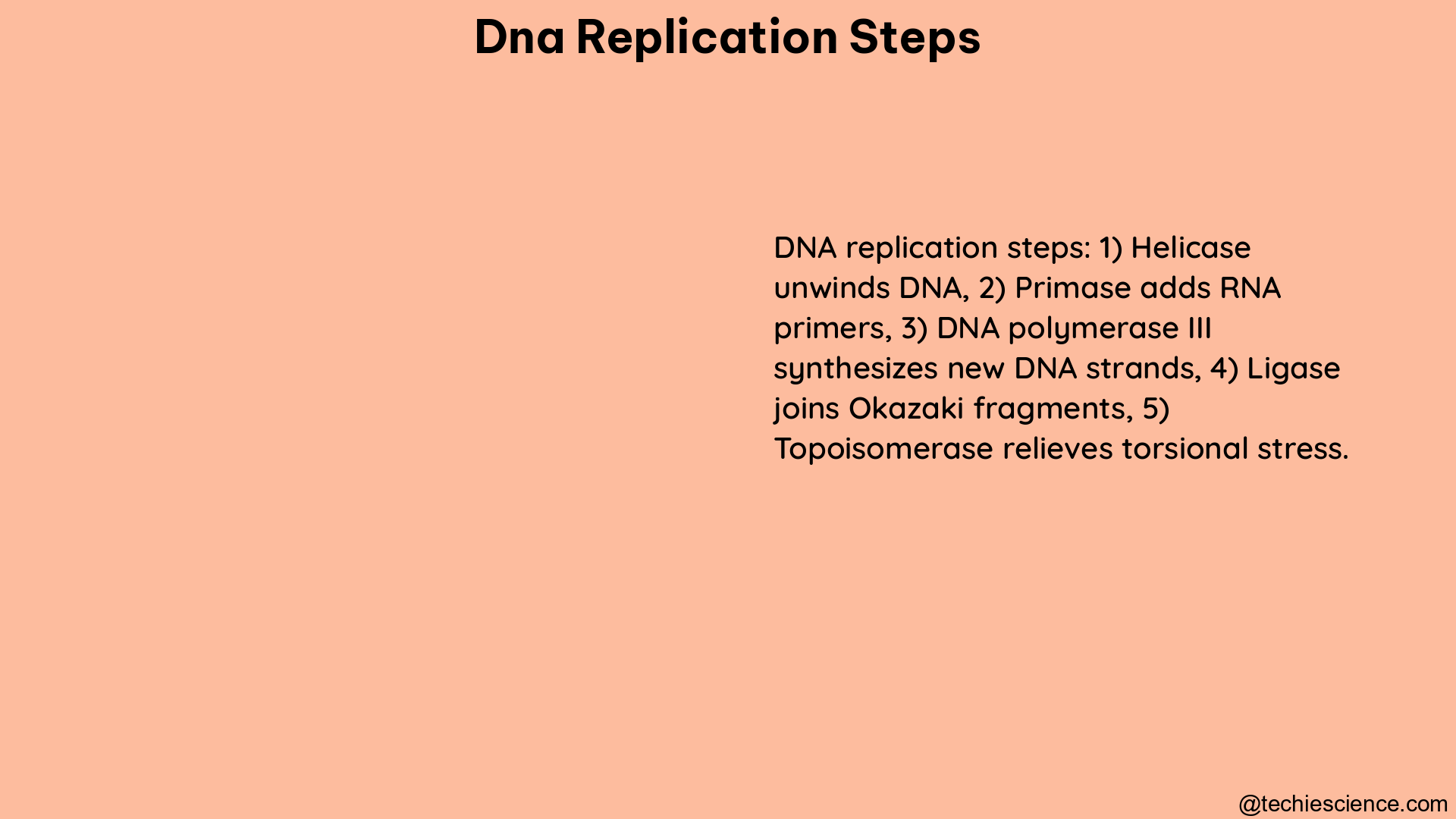DNA replication is a fundamental process in biology, responsible for the accurate duplication of genetic information, ensuring the faithful transmission of genetic material from one generation of cells to the next. This complex and precisely orchestrated dance involves a series of carefully choreographed steps, each playing a crucial role in the overall success of the replication process. In this comprehensive guide, we will delve into the intricacies of DNA replication, exploring the biological specifications and advanced hands-on techniques that shed light on this remarkable feat of molecular engineering.
Initiation: Unlocking the Replication Origins
The DNA replication process begins with the recognition and binding of the origin recognition complex (ORC) to specific sites on the DNA molecule, known as origins of replication. These origins serve as the starting points for the replication machinery to assemble and commence the duplication of the genetic code. The ORC then recruits additional proteins, including Cdc6 and Cdt1, to form the pre-replication complex (pre-RC), setting the stage for the next crucial step.
Helicase Loading: Unwinding the Double Helix

Helicases, a class of protein complexes, play a vital role in DNA replication by unwinding the double helix of DNA, providing access to the genetic information. The minichromosome maintenance (MCM) complex, a type of helicase, is loaded onto the pre-RC, forming the preinitiation complex (pre-IC). This step is essential, as the unwinding action of the helicase is a prerequisite for the replication machinery to begin its work.
Priming: Laying the Foundation for Replication
Before DNA replication can commence, an RNA primer must be synthesized by the enzyme primase. This primer serves as a starting point for DNA polymerase, the enzyme responsible for adding nucleotides to the growing DNA strand. The primer provides a crucial anchor, allowing the replication process to kick off seamlessly.
Elongation: The Zippering of DNA
DNA polymerase, the workhorse of DNA replication, adds nucleotides to the 3′ end of the RNA primer, extending the new DNA strand in the 5′ to 3′ direction. This process continues, with the polymerase “zippering up” the DNA molecule, creating a complementary copy of the original strand. The directionality of DNA polymerase ensures that the elongation proceeds efficiently, with the newly formed double helix winding back up behind the replication fork as the process progresses.
Termination: Bringing the Replication Dance to a Close
DNA replication terminates when the replication fork encounters another replication fork moving in the opposite direction or when it reaches the end of the template strand. This critical step ensures that the replication process comes to a complete and orderly end, preserving the integrity of the genetic information.
Biological Specifications of DNA Replication Steps
DNA Helicase: The Unwinding Maestro
DNA helicase is a crucial player in the initiation of DNA replication, as it unwinds the double helix, providing access to the genetic code. Without this unwinding action, the replication machinery would be unable to copy the DNA. Helicases, such as the MCM complex, use the energy from ATP hydrolysis to power the unwinding process, creating the necessary conditions for the replication machinery to begin its work.
RNA Primase: The Priming Catalyst
RNA primase is an essential enzyme for the synthesis of a new DNA strand, as it ensures that the replication process kicks off correctly. Primase synthesizes short RNA primers that serve as starting points for DNA polymerase to add nucleotides, initiating the elongation of the new DNA strand.
DNA Polymerase: The High-Fidelity Replicator
Different types of DNA polymerases have specific functions, such as adding nucleotides to the new strand and proofreading the newly synthesized DNA to correct any errors. The high fidelity of DNA polymerase is vital for maintaining genetic stability across generations of cells. Polymerases like DNA Pol III in bacteria and DNA Pol α, δ, and ε in eukaryotes work in coordination to ensure the accurate replication of the genetic material.
Elongation of DNA: The Zippering Process
During the elongation stage, DNA polymerase continues adding nucleotides to the primer, creating a complementary copy of the original DNA strand. The directionality of DNA polymerase, which adds nucleotides in the 5′ to 3′ direction, ensures that the elongation process proceeds efficiently. As the replication fork moves forward, the newly formed double helix winds back up behind the fork, maintaining the overall structure of the DNA molecule.
Termination: Ensuring a Tidy Conclusion
Termination of DNA replication is a critical step, as it ensures that the process comes to a complete and orderly end. This can occur when the replication fork encounters another replication fork moving in the opposite direction or when it reaches the end of the template strand. Proper termination is essential for preserving the integrity of the genetic information and preparing the replicated DNA for subsequent cellular processes.
Advanced Hands-On Techniques
Quantification of Nucleotide Analogue Incorporation
One powerful technique for studying DNA replication dynamics is the use of nucleotide analogues, such as bromodeoxyuridine (BrdU). These analogues can be incorporated into replicating DNA, and the amount of BrdU incorporated can be quantified using methods like flow cytometry or immunofluorescence. This approach provides valuable insights into the replication kinetics and the distribution of replicating cells within a population.
DNA Copy Number Analyses
DNA copy number analyses can be used to accurately reconstruct the genomic replication timing profiles of various species and cell types. By measuring the relative DNA copy number at different stages of the replication process, researchers can gain insights into the timing and efficiency of DNA replication. This information is crucial for understanding the regulation of DNA replication and its implications in cellular processes, such as cell cycle control and genome stability.
Single-Cell Replication Timing Assays
Recent advancements in single-cell analysis techniques have enabled the study of replication timing at the individual cell level. Single-cell replication timing assays reveal a new level of regulation, as they can uncover the variability and heterogeneity of DNA replication within a population of cells. This approach provides a more nuanced understanding of the factors that influence replication dynamics and their potential impact on cellular function and development.
By delving into the intricate steps of DNA replication, we have gained a deeper appreciation for the remarkable precision and complexity of this fundamental biological process. From the initial recognition of replication origins to the final termination of the replication dance, each step plays a crucial role in ensuring the accurate duplication and transmission of genetic information. The biological specifications and advanced hands-on techniques discussed in this guide offer a comprehensive understanding of the DNA replication machinery, empowering researchers and students alike to explore the frontiers of this captivating field of study.
References
- Khan Academy. “Molecular Mechanism of DNA Replication.” https://www.khanacademy.org/science/ap-biology/gene-expression-and-regulation/replication/a/molecular-mechanism-of-dna-replication
- Vaia. “List the Steps in DNA Replication.” https://www.vaia.com/en-us/textbooks/biology/human-genetics-concepts-and-applications-12-edition/chapter-9/problem-15-list-the-steps-in-dna-replication/
- NCBI. “Molecular Mechanisms of DNA Replication Initiation in Eukaryotes.” https://www.ncbi.nlm.nih.gov/pmc/articles/PMC7131883/
- NCBI. “Replication Timing: The Early Days of a Better Nucleus.” https://www.ncbi.nlm.nih.gov/pmc/articles/PMC6212846/
- BioNumbers. “How long does it take to replicate the human genome?” https://book.bionumbers.org/how-long-does-it-take

I am Abdullah Arsalan , Completed my PhD in Biotechnology. I have 7 years of research experience. I have published 6 papers so far in the journals of international repute with an average impact factor of 4.5 and few more are in consideration. I have presented research papers in various national and international conferences. My subject area of interest is biotechnology and biochemistry with special emphasis on Protein chemistry, enzymology, immunology, biophysical techniques and molecular biology.